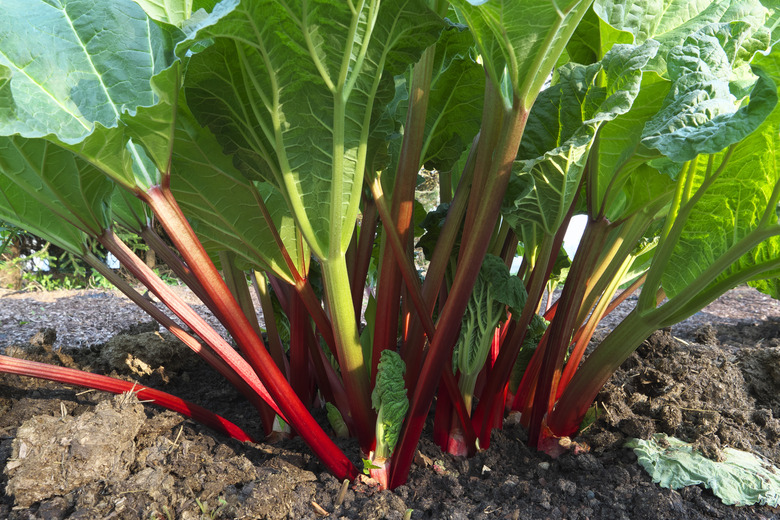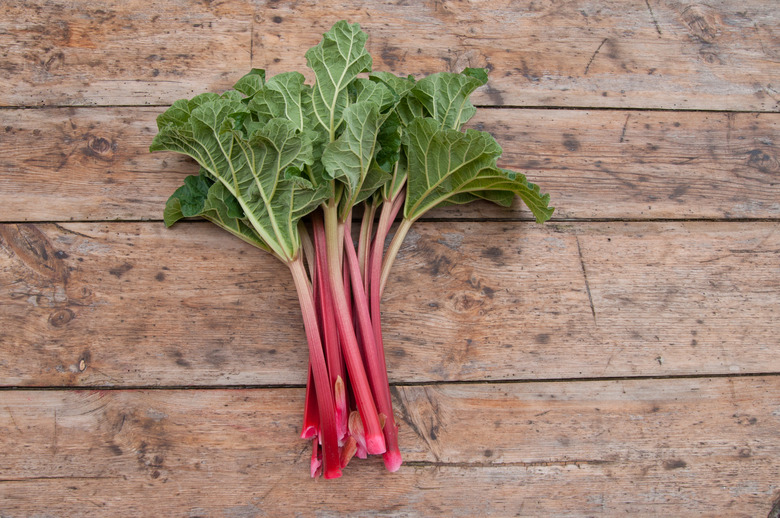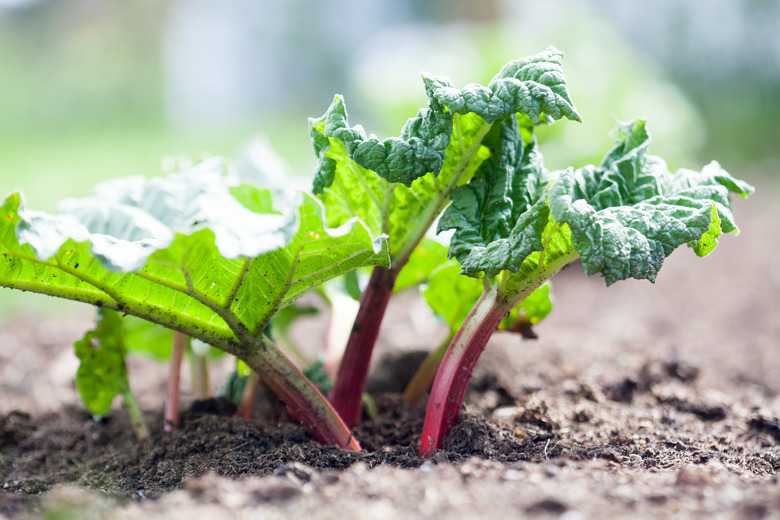How To Grow Rhubarb
We may receive a commission on purchases made from links.
The rhubarb plant (Rheum rhabarbarum) is a large, colorful, perennial vegetable plant that prefers cooler temperatures and makes a fine addition to a garden. When fully grown, it boasts large, green leaves and bright-red, pink or greenish-pink stalks that resemble celery in appearance. While the stalks can be harvested and used in a variety of different recipes, the leaves are toxic if eaten in large quantities and should be discarded.
Rhubarb is a simple plant to grow, but there are a few things to keep in mind. The age of the plant, heat and stress can all cause the plant to bolt, which can reduce the harvest. Also watch for seed pods on some varieties, which have the same effect. Unlike many other vegetables, if rhubarb flowers, it won't ruin the taste of the plant, but it will divert energy from its growth. Unless the rhubarb is being cultivated as an ornamental, remove any seed pods or flowers as soon as they appear to keep the energy focused on growing stalks for harvest.
Rhubarb is a fast grower and a low-maintenance plant that is extremely hardy. It is a perfect pick for beginning gardeners with enough space to accommodate it.
Best Uses for Rhubarb
Best Uses for Rhubarb
Rhubarb is suitable both as an ornamental and for use as a vegetable in recipes. It can be grown in a front yard as decorative planting, added to a garden plot for harvesting or even put along a fence line or flower bed area just to showcase its attractive appearance. While it is possible to grow a rhubarb plant in a container, it will need to be a deep one. This vegetable has a fairly extensive root system, so choose something that is a minimum of 20 inches deep to make sure it's suitable. Keep that in mind for planting beds as well.
The rhubarb plant yields a good bounty once it is fully established, and if it is to be used for consumption, there are many different recipes that take advantage of its unique, tart taste. Many people like to grow this plant to make strawberry rhubarb pie, and the vegetable is sometimes even referred to as the "pie plant." That said, there are many other ways it can be used in cooking. Rhubarb: 50 Tried & True Recipes is a cookbook that highlights some interesting recipes, including drinks, sauces, desserts and more.
There are many different cultivars of rhubarb plants, so there are plenty from which to choose when planting. Some of the popular cultivars include 'Canada Red,' 'Cherry Red,' and 'Valentine.' Flavor doesn't necessarily correspond to color, so it can be wise to do a little research before deciding which cultivar to grow. If you are planting as an ornamental, select a cultivar on its visual appeal and full-grown size. Some are larger than others. Rhubarb also produces flowers late in the growing season, which adds to its appearance.
Starting Rhubarb From Seed
Starting Rhubarb From Seed
Starting plants from seed takes longer, and it's a bit more difficult to get a good crop, especially in warmer climates where the growing season can be shorter. Gardeners usually grow this plant from a crown, which can be ordered online or from a nursery. Crowns can also be obtained from a friendly neighbor who is willing to share.
Starting Rhubarb From Seedlings
Starting Rhubarb From Seedlings
Although it is possible to grow rhubarb from seed, planting rhubarb crowns is the preferred method. Be sure to space the crowns about 4 feet apart from one another so they have plenty of room to grow as they mature and fill in. Plant them no more than 2 inches below the surface in a garden bed that has been dug out, enriched with compost, and loosened. These holes should be large, about the size of a bushel basket.
In What Zone Does Rhubarb Grow Best?
In What Zone Does Rhubarb Grow Best?
Rhubarb grows best in USDA plant hardiness zones 3 through 7 or 8. As a cool-weather plant, it doesn't care for very hot climates and really prefers a maximum temperature of somewhere around 75 degrees. That said, it's possible to grow it in warmer areas, but the harvest period may be shorter, and the plant will not return again the next season. Generally, those living in zones 9 and warmer will need to treat this vegetable as an annual.
When Should You Plant Rhubarb?
When Should You Plant Rhubarb?
Plant rhubarb crowns or divisions early in the spring season as soon as the ground is able to be worked. Rhubarb can also be planted in the fall for the following season but make sure the vegetable is dormant before putting it in the ground.
Soil, Sunlight and Water Recommendations for Rhubarb
Soil, Sunlight and Water Recommendations for Rhubarb
The rhubarb plant does best in full sun, although it may tolerate some shade, especially in warmer climates. In cooler areas where it will overwinter, this plant will come back each year and can be left in the same place for as long as it survives, which can be decades. There is no need to relocate it as with some vegetables, as it isn't prone to nematodes (roundworms) or other pests that attack many garden plants. This makes it an extremely easy-care vegetable.
All of that aside, the one thing that needs to be done well for rhubarb to thrive is proper soil preparation. The rhubarb plant is a heavy feeder and needs fertile soil to establish itself and thrive in the garden. Be sure to work in a nice, deep layer of compost to accommodate its growing needs and this plant will do very well.
Don't bother with fertilizer, as it can be too much for the plant initially. Just be generous with the compost and make sure to water plants regularly. Keep in mind that this plant likes moist soil but doesn't like sitting in water. Aim for somewhere in between and make sure the soil is loose enough to provide good drainage as well as some space for the root system to grow freely.
How to Propagate Rhubarb
How to Propagate Rhubarb
Rhubarb is very easy to propagate. Once a plant is established, simply divide the crown area in the early spring or fall when it is dormant. Use a sharp spade or shovel to cleanly slice through the plant and the roots, and choose sections with at least two buds on them to replant. Try not to disturb the buds when separating or planting. Healthy rhubarb plants can be divided every few years without issue, and it can help the plant continue to do well.
How to Winterize Rhubarb
How to Winterize Rhubarb
Rhubarb is a perennial plant when grown in zones 3 through 7 or 8, but it does need a bit of protection from severe cold over the winter season. Just before or right after the first freeze, cut back the stalks and spread a thick layer of mulch over the top of the plant. Compost can be used instead as an easy way of preparing the plant for the following spring growing season if preferred, or both can be used.
How to Harvest Rhubarb
How to Harvest Rhubarb
Harvesting rhubarb isn't a complex task, but the plant should be left alone for the first season so it can get fully established. In the second growing season, stalks can be harvested if the plant is filling in well. If it still looks a bit sparse, give it one more season to be safe or harvest lightly, choosing just the larger stalks. Keep an eye on the size of the stalks in general and if they begin to thin, stop harvesting since that means plant growth is slowing.
Once the rhubarb stalks are ready, simply give a quick twist at the base, pulling at the same time, or use garden scissors to cut the stalks. Most rhubarb plants can have stalks removed once they reach 12 or more inches but be sure to check on the cultivar that is planted for the full-grown height. If preferred, the stalk can also be removed by cutting it with a sharp knife. When harvesting, remember that the leaves of this vegetable contain oxalic acid and are toxic when eaten in large quantities, so remove them completely and discard them before preparing any recipes.
Once a few years have gone by and the plant is fully established, it's possible to have a harvest season that lasts for two months or more. Leaving some of the stalks on the plant will help make sure it keeps producing and isn't overharvested in areas where the plant is a perennial. In those warmer areas where the plant is an annual, all of the stalks may be harvested before the hot weather settles in or before the plants bloom.
Common Pests and Other Problems for Rhubarb
Common Pests and Other Problems for Rhubarb
Rhubarb is an extremely hardy plant with few issues. In terms of pests or problems, there really aren't many. There may be a few bugs, such as slugs and aphids that could appear, but generally, if the plant is well taken care of and the soil is properly weeded, rhubarb should be pretty pest-free. Mulch helps retain moisture around the plant, and it also reduces weeds in the bed or garden area. If weeding is needed, try to be careful not to disturb the roots of the rhubarb plants.
Common Diseases for Rhubarb
Common Diseases for Rhubarb
As with pests, the rhubarb plant doesn't have very many issues with disease. The one thing of which to be wary is crown rot, which is sometimes a problem for this vegetable. As with most forms of rot, excess moisture is the culprit. To help prevent this issue in rhubarb plants, be mindful of the planting location to help ensure it doesn't pool water. Also, if the region is prone to clay soils, consider planting in a raised bed to prevent moisture-related soil problems that can lead to rot. Soil can also be slightly mounded up when planting to help prevent the crown of the plant from sitting at ground level and collecting moisture.


